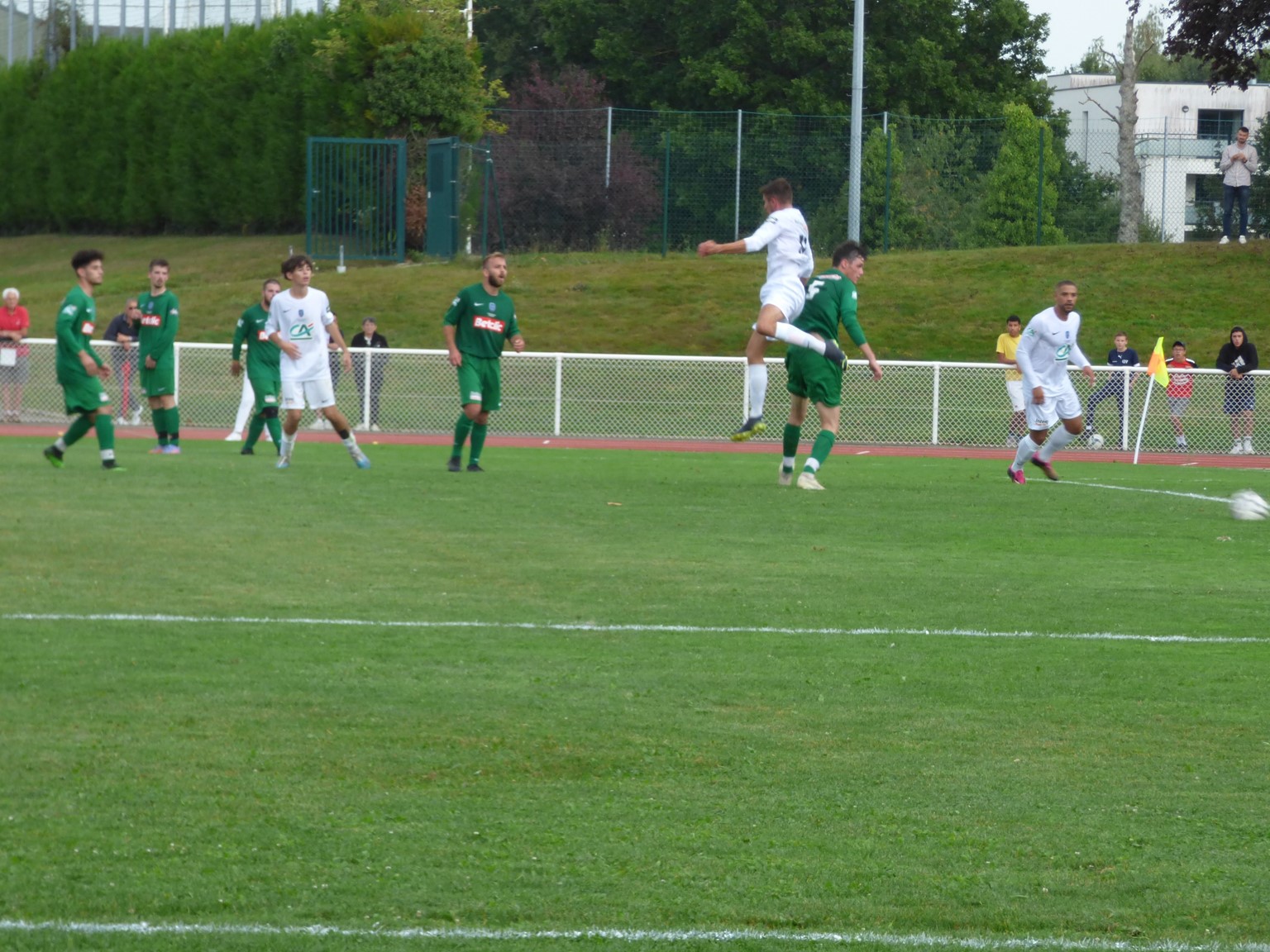The Magic of the Coupe
It is no secret that I love the Coupe de France. In fact, I will argue with anyone who does not believe it is the best of all the domestic competitions in the world.
The reason for this is its openness. The English cup may be famous, and the World’s oldest football competition, but it limits its entry to just over 700 clubs, with strict rules over the levels clubs play at, and the facilities available. In France, ten times as many clubs enter and there is simply no limit to the level a club can play at and still be involved. France, I believe has more teams, and probably more clubs than England. Where I live, the lowest level (Orne Departmental 4) is tier 12 and there is nothing lower – but the pyramid has a wider base so there are far more divisions at tier 12. Tier 12 means that 11 promotions will get a club from the bottom of the system to the top.
Greater independence of local authorities, and the fact that the provision of sporting facilities appears to be a matter of pride means that even the smallest village tends to have a ground with a railed off football pitch and dressing rooms close by. The massive playing field systems with a dozen or more pitches sharing a single dressing room block are rare in France. This does mean that minimum facilities is not generally an issue.
Metropolitan France is divided administratively into 13 regions, (which includes Corsica). In France the football follows the administration. When the number of regions was reduced a few years back, the number of Regional Football Federations was reduced to mirror this. For example, where I live Basse-Normandie and Hauts-Normandie were combined to give a single region of Normandie, and within a year, the football federations were merged to match. Each of the regions is allocated a number of places in the seventh round of the Coupe. It is in the seventh round, that Ligue-2 teams enter and the draws are made by the National Association, the FFF.
The number of places in Round 7 are certainly not by the areas population and are probably more attuned to the number of clubs in the area. Hence in 2021-2, Bretagne had 14 places in Round 7 while Paris Ile de France had only 11. PIDF has about 3.5 times the population of Bretagne.
Like many European countries, France still has a few overseas territories left over from the days of empire. As a general rule, these are happy with their status. France differs from most other countries, in that it integrates these territories more than other countries. The remains of the French Caribbean, Mayotte and Reunion off the African Coast and the Islands of St. Pierre and Miquelon are all considered integral parts of France, even to the point of being in the EU. Those territories in the Pacific appear to be more at arm’s length, perhaps due to the length of the arm needed to fold them in.
This incorporation extends to the Coupe de France, which appears to be a unique situation in World Football.
The history of this goes back to the 1960s, with a team from Guadeloupe playing FC Dieppe in mainland France on 1961. The following year it was a Martinique side, while a year later CA Montreuil went to Martinique to play. In 1964, Jeunesse Saint-Pierroise (Reunion) became the first club from the African territories to take in a match against a mainland team. Two years later, Nouvelle-Caledonia featured, although this was the last Pacific side until a Polynesian side entered 8 years later
Another landmark in 1974 was from Golden Star of Martinique. They drew at home with US Melun, (then at the third level of French football), and then won the replay (which I think was also in Martinique). This was the first win for the overseas contingent and won Golden Star a trip to the mainland. Their opponents were top division side OGC Nice and unsurprisingly, the islanders lost 8-0.
This was the first of quite a few. Six more territorial sides had beaten mainland sides by the end of the decade.
On 11 June 1988, my personal odyssey reached beyond British shores for the first time, passing through Paris for a work assignment, I rolled up at Parc des Princes and easily picked up a ticket (yes, from a tout), to see Metz play Sochaux in the Coupe de France final. At the time, I would have been unaware of the inclusion of the Outre Mer sides. At the time, there were matches in the seventh round, with two clubs from Reunion playing each other, and two more matches mixing the various Caribbean teams. The winners of these matches, along with one from French Polynesia and another from Martinique played in the eight round. All lost on this occasion, and this was the round before the top division sides entered.
Over the years, I watched more football around the continent, (and for that matter, further afield), and I became more aware of the full scale of the Coupe de France, the sheer number of clubs involved, and the speciality that is the clubs of the Outre Mer. I started looking for opportunities to watch these teams in France. As by that time, I had a season ticket for Cheltenham Town, and also did not like to miss the First Round FA Cup game for Cheltenham, (which frequently clashed with the seventh round of the Coupe de France).
So it was not until 2008 that I finally got to see some Outre Mer teams play in France. The matches were played in mid-November and it was freezing all weekend. I was fairly lucky with the fixtures with the SR Colmar v AS Tefana game being played Friday night. I flew into Zweibrucken (Germany) and hired a car to get me across the border. Tefana are a representative of French Polynesia and had made a lengthy journey, travelling via Los Angeles, Paris and Strasbourg before boarding the coach for the final part of the journey. It is also a fair bet that the islanders had never played in such freezing conditions, the temperature being below freezing throughout more than two hours of football. Despite the difficulties the Polynesians faced, the deadlock in the game was not broken in the first 90 minutes. Three minutes into extra time though, and things looked different after Pape Dieye scored for SR Colmar. This may have been too much for Tefana, but they fought on and got their reward four minutes before the end, when one of their substitutes, Petillon would get an equaliser. And so to penalties, Tefana shot first, scoring – followed by Colmar’s shot missing the target. After two more good penalties from each side, Tefana kept up their record scoring their fourth. Xavier Samin saved the next to give the visitors the victory. This was the third season in a row when AS Tefana had been the French Polynesian representatives, but this was the first time they would progress.
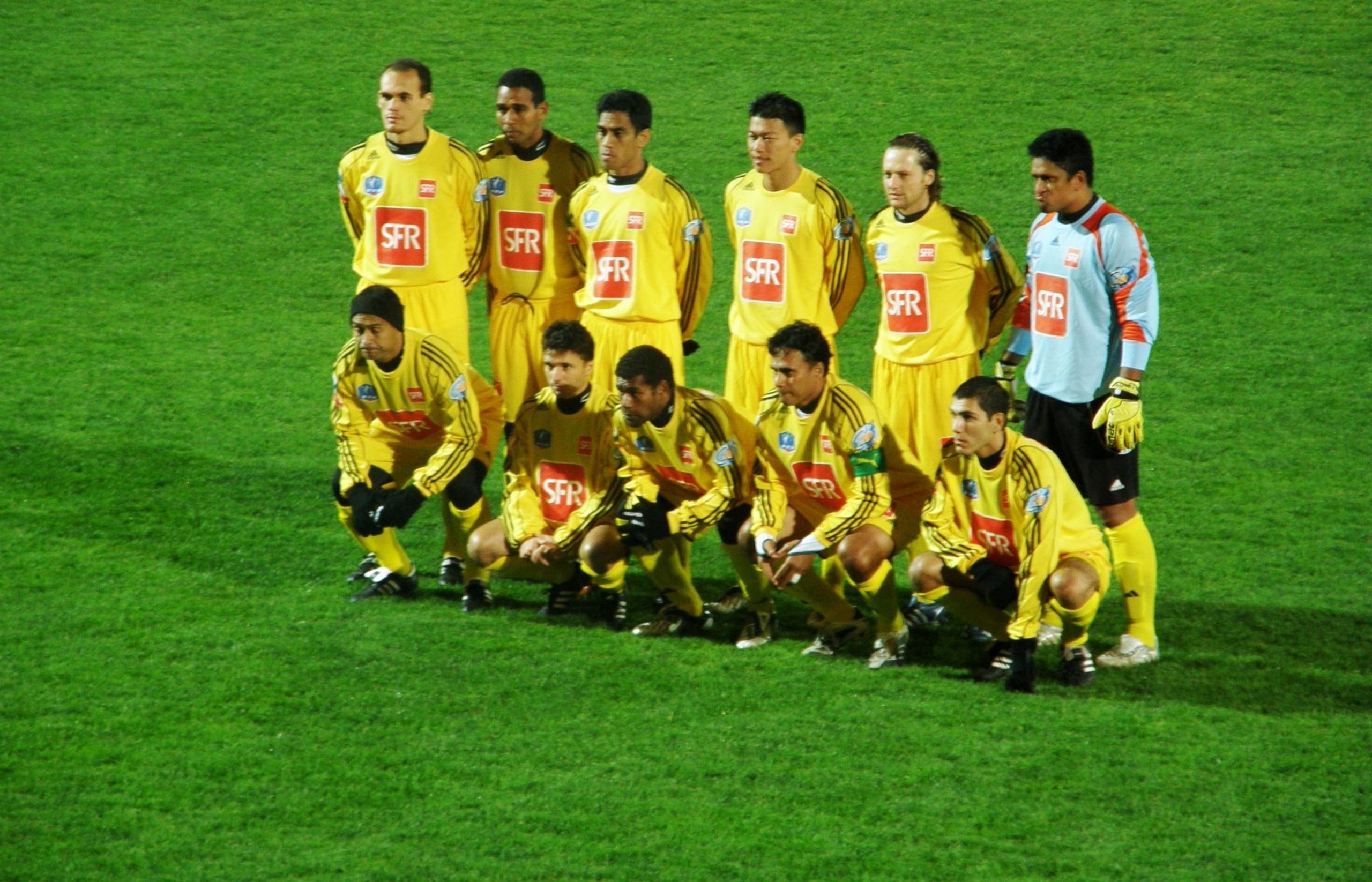
AS Tefana pictured before their match in Colmar, 2008
I stayed in Colmar overnight and made the short journey the next day to St. Louis Neuweg, where the home team were playing against the Reunion representative, Jeanne D’Arc le Port. The stadium in St. Louis is known as the Stade de la Frontiere, as one could imagine a misplaced clearance going the 100 meters or so to the Swiss border. The Dreilanddereck point, where Switzerland, Germany and France all meet together is barely a km away, (the action point is in the middle of the Rhine). Again the honour would fall to a substitute, as within three minutes of coming onto the field, Sully Cerveaux would score for the African side.

Fans of Jeanne D’Arc in St. Louis Neuweg
The Saturday game was in the afternoon. Most French football on Saturdays takes place later in the day, so I got to travel further north and through an expensive toll tunnel to a snowy Raon l’Etape to see them beat their neighbours SRD St. Die by 1-0. I remember this one as they have a very nice, open and club orientated clubhouse (not that common in France). Also I recall the start of the second half delayed as the referee ordered that they needed to complete the sweeping of one end of the field. The home club had the snow from both penalty areas, but on the wings only at the end they were attacking. It had the be evened up. As I flew into Germany, I returned to German football for the Sunday
There was another groundhopper I met at both of the first two games of this trip. He called himself the hitchhiking groundhopper, (and had a printed card to say this). Unlike most groundhoppers, who need to see all 90 minutes, the hitchhiker considered he had made the game if he got there before the end. I suppose a necessity when you are using such an unreliable mode of transport, but not something I could comprehend. Still, he was safe for his evening game after St. Louis Neuweg, as he was walking across the border in Switzerland and I think he may have had time to walk all the way to Satde Ronhof to see Concordia Basel.
We met again in the same round the following season, and again to see an Outre Mer side playing. This time is was Kawemi from Mayotte, visiting US Quevilly in Normandie. Football in Rouen and Quevilly is worthy of a blog post on its own, such are the goings on between the clubs in the city. For the uninitiated, which at the time in question included me, Quevilly is those suburbs of the Rouen city immediately south of the River Seine. The area is divided into Petit Quevilly and Grand Quevilly. The main Rouen football stadium is in Grand Quevilly. US Quevilly at the time played in Petit Quevilly.
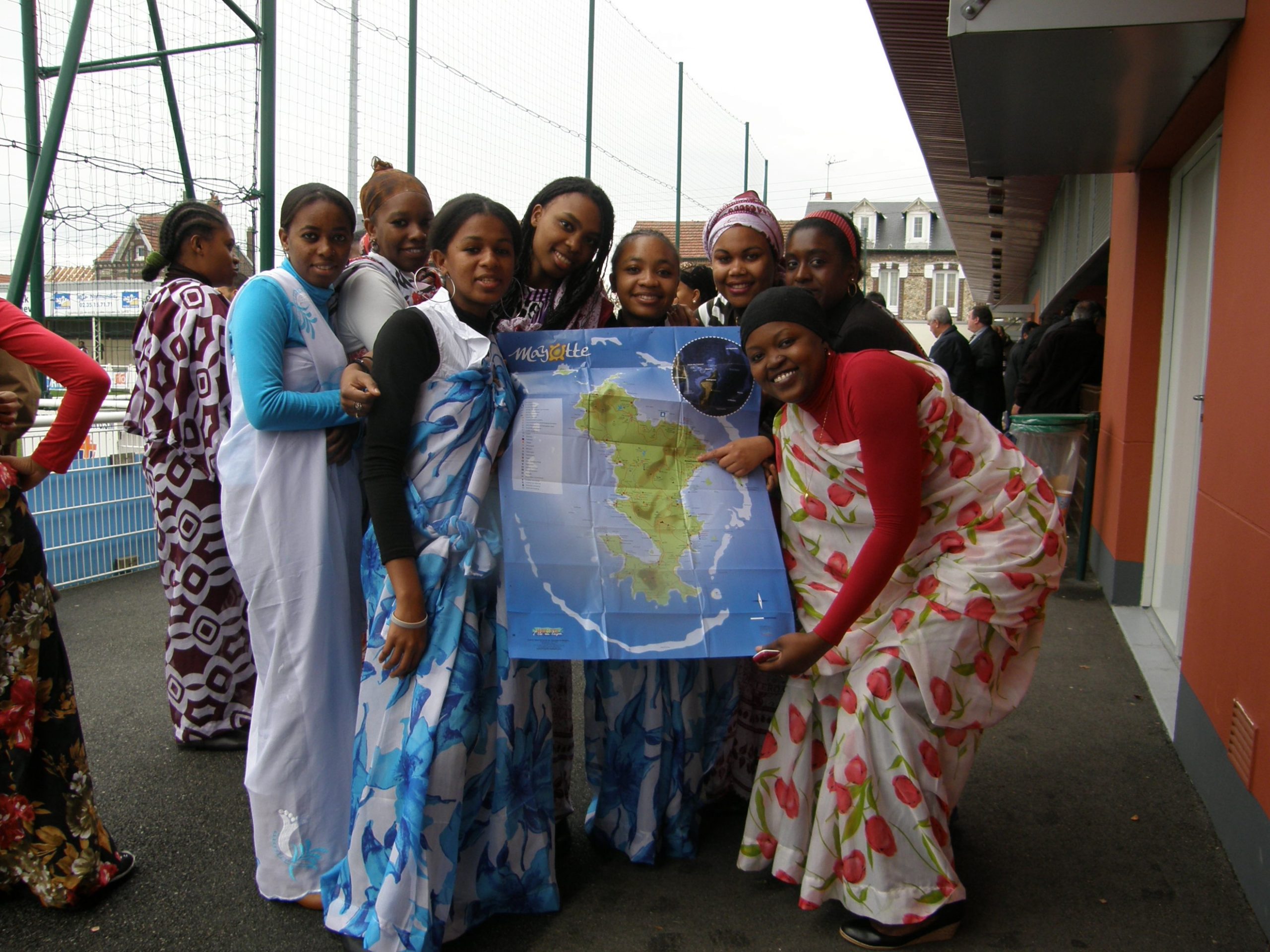
The ladies from Kawemi point the town out on a map. Loved the costumes
Sadly, this was not the breakthrough game for the Mayotte side, they lost 6-0 to the fourth tier Quevilly club. Mayotte were not to get against mainland sides until 2021. It was however, part of US Quevilly’s longest cup run. In the next round, they travelled to Pacy-Vallée-d’Eure, (one level above them), winning the tie with two extra time goals. Then then beat St. Quentin 6-0, and followed this with home wins over Angers (Ligue-2), Rennes and Boulogne (both top division at the time). Hence they reached the semi-finals before PSG put a halt to their run, (and then just by 1-0)
My hitchhiking friend wanted me to travel further west after the Quevilly game, to see one of the other outre mer teams in action. I was tempted, but on doing the maths I would out that I could not make it back from there to the Channel Tunnel in time for the last shuttle before midnight – and if I missed that, my return fare would take a stratospheric rise. So, I stayed in Rouen, to see FC Rouen play Beauvais-Oise, a 4-2 aet away win, and then headed closer to Calais to see Compeigne at home in a Sunday match.
At this time, I had a fair idea of how the matches were panning out. There were 7 Outre Mer territories entering the Coupe. All came in at the seventh round. The same point as French Second Division teams enter. The top division comes in two rounds later. In 2008, I saw teams from French Polynesia and Reunion in mainland France, and a team from Guadeloupe also visited the mainland. This meant that these three territories were to play their 7th round games in 2009 in their home “country”. The two I saw win their games were also given home draws in the next round. As it happened, the Guadeloupe side, Evolucas had played and lost to Feignies, up near the Belgian border, and it was Feignies that then travelled to Reunion in the next round. Jean d’Arc won that as well, reaching the 9th round, (which in France is referred to as either the Round of 64 or the 1/32 Finals). Jean d’Arc lost to Tours of the second division at that point.
The appearance of Fiegnies in the draw against Outre Mer teams twice in a row is not a surprise. The FFF gets a list of volunteer teams to play in the 7th and 8th rounds against the outre mer teams. Generally it seems they come from the National 2 and 3 Divisions (tiers 4 and 5), but lower teams featured in both the games won by a team from Mayotte, Jumeaux de Mzouasia in 2021 – and even second division teams have featured more recently.
While I saw a couple of other Coupe matches in the meantime, the Outre Mer selections were not within my reach again until 2014. The season bought an increase in the number of Outre Mer clubs at the 7th round stage. Four of the territories, Reunion, Guadeloupe, Martinique and French Guyana were allowed a second team, and for these, each territory would have one team playing at home, and one travelling to the mainland. French Polynesia, Nouvelle Caledonie and Mayotte were still at one representative each. The Polynesian representative was again AS Tefana, and having gone on a family weekend to Paris, I managed to get out to see them play as Noisy-le-Sec, with the team from the Banlieue winning in extra time. (The full name of the team at the time, was AS Noisy-le-Sec Banlieue 93, Banlieue refers to the suburbs around Paris, and 93 is the department number – Seine St. Dennis, home of the Stade de France).
I would see a team from Guadeloupe, Phare du Canal playing in a disappointing game in Belfort in 2014, but it was in 2018 that I really the island of Guadeloupe loomed higher in my adventures.
The full details of the game, with a few photos can be found on my facebook page, at https://www.facebook.com/leo.hoenig/posts/10156624888529627 – and on this blog, there are a number of posts, starting with http://leohoenig.com/?p=1680
By this time, I had a base in France, and did not have the restrictions imposed as a working man. So, I could book a return flight from Paris to the Caribbean for a few weeks prior to Christmas. Fares were good, so long as one flew to Guadeloupe and or Martinique and I picked up a good round trip including both – although it was always my intention to visit other islands as well. I had spent a lot of time prior to starting the journey trying to compare fixture lists in different places, but I still had a lot of flight and hotel bookings to make before I set out.
I had to make my original booking, for the flight across the Atlantic, well before the draw for the seventh round of the Coupe had taken place. What I did know was that there should be a game in Guadeloupe that weekend. What I had missed was the effects of the CONCACAF Nations League. At the time, a new competition, this included all the sides in CONCACAF, including those from the Caribbean that were not full members of FIFA. And hence, the Coupe de France games were no longer the only major matches for Guadeloupe teams for the week.
As such, my plan to travel on Friday to see a Coupe match on either Saturday or Sunday, and hopefully a league game or two as well, was in tatters. The Coupe match would be on the Friday, to allow more time for the international players to prepare for their game on the Monday. By the time I knew that the match was kicking off at 20.30 Friday night, it was far too late to change a flight due to arrive 19.40 to same day.
Amazingly, everything then worked out. While I arrived in Guadeloupe and found one car hire company with a massive queue, my hire car was a doddle, and I arrived at stadium before scheduled kick off. With the time taken to park and find my way in, it was after 20.30 when I was in sight of the pitch, but the players were still doing the pre-match photos. Cote Bleue, then a fifth tier team would be the homesters by 3-1, leaving me with just the problem of finding my AirBnB for the night, (and it was a problem).
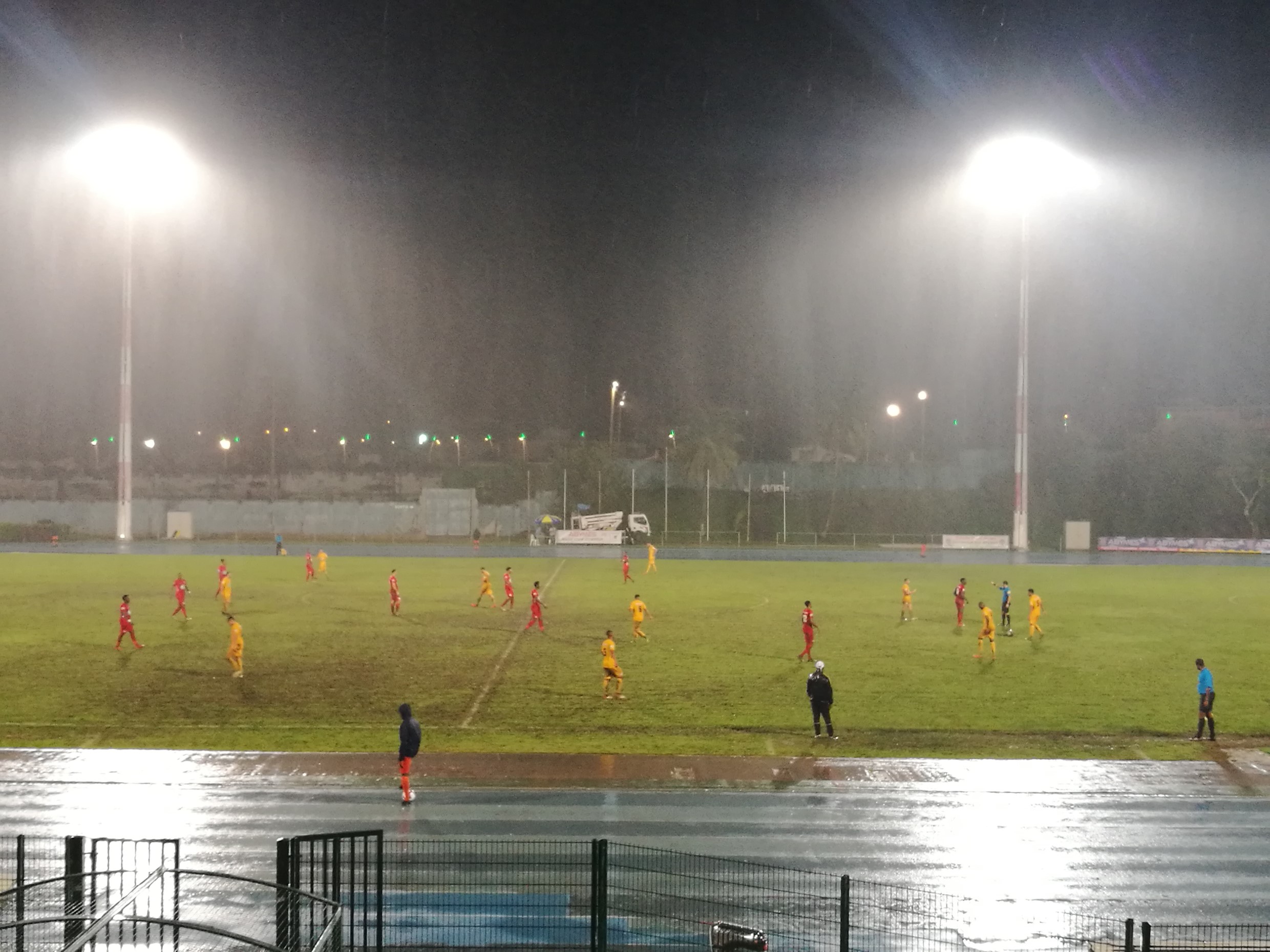
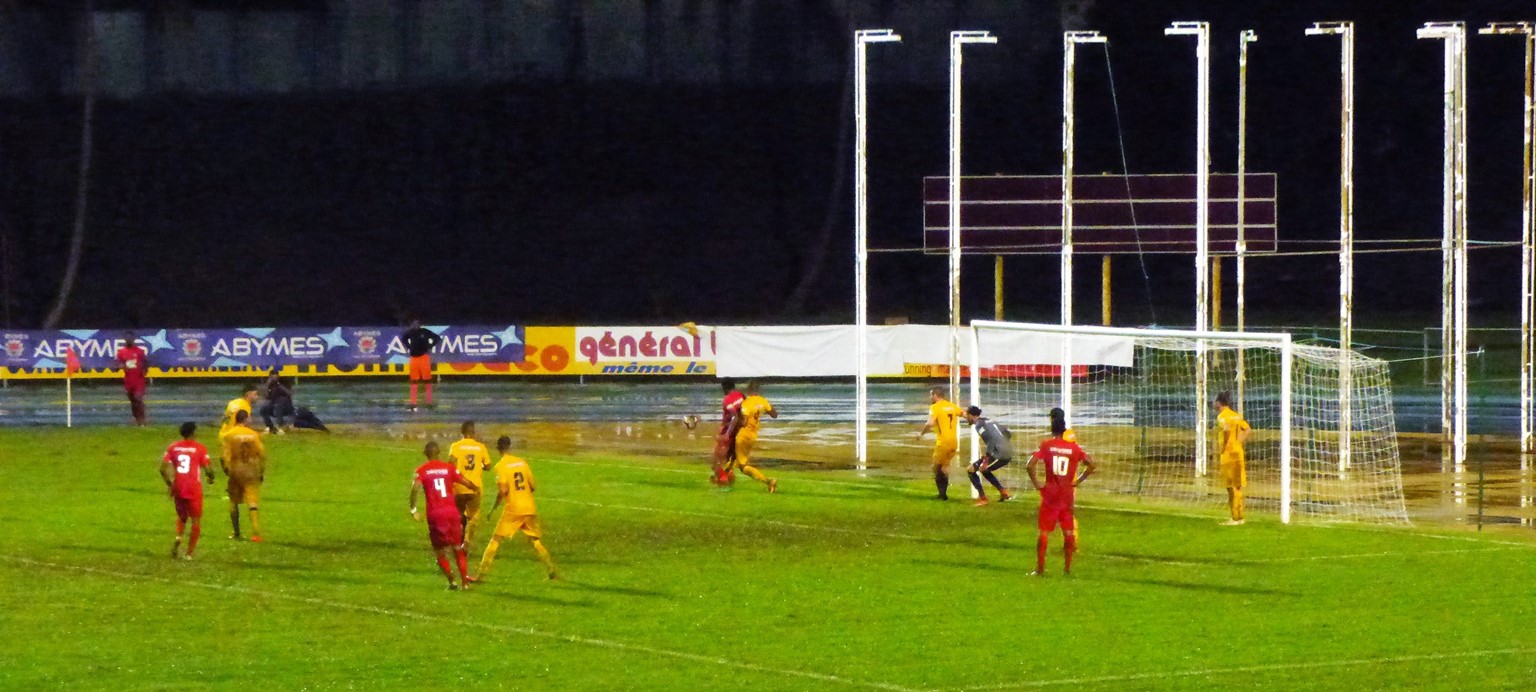
A wet night in Guadeloupe, with US Sainte Rose in Red
I have seen many more games in the Coupe de France since this – for me the first half of the season is dominated by the games, which turn up every second weekend. I wonder about trying to see a match in every round within a season, but after the 1/16 finals, it becomes difficult with three rounds of midweek games. It also should be noted that France is a big country and it is far more difficult to get to its ends than in England.
Also in 2018, and before I went to Guadeloupe, St. Pierre and Miquelon made their first entry into the cup. The islands only have three teams, with AS St. Pierre being the first to visit mainland France losing 2-1 to ALC Longvic, a seventh tier team in the Bourgogne-Franche-Comté region.
A change for 2019 meant that although Guadeloupe, Martinique and French Guyana had two teams in the seventh round, they would play each other and it would be in the eighth round that one team from each territory would play mainland opposition. Both Reunion and Mayotte would get the same treatment in 2020, which of course meant an extra place in Round 7 for Mayotte. JS Saint Pierroise of Reunion became the most successful Outre Mer club in the cup in 2019-20 season, with no less than four matches against mainland opposition. A win at fourth tier Jura Sud in Round 7 gave them a game at home to Thaon (fifth tier). This one went to penalties, but then in the round of 64, they did really well with 2-1 win away to Ligue-2 side Chamois Niortois. Travelling back to mainland for the next round, they again played a fourth tier team, but lost to Epinal. This is the only time an Outre Mer team has appeared in the last 32 and of course the most mainland teams beated by a single Outre Mer team in a season
A quick word about Chamois Niortois – they are really named after Chamois Leather. The founder’s father owned a Chamois Leather factory, and the badge features a Chamois goat, the traditional source of the leather.
Saint Pierre and Miquelon’s representative in 2019 was AS Ilienne Amateurs, they played a seventh tier team, FC Lyon and lost 5-1.
The Outre Mer involvement in the Coupe was ended before the first COVID shutdown, but in 2020-1, everything was severely held up by this. The Saint Pierre and Miquelon representative was again AS St. Pierre, but they could not travel and La Roche Vendee Football were given a walkover. The two Pacific territories, Nouvelle Caledonie and French Polynesia did not enter sides.
The delayed competition still had the seventh round ties as planned, with each of the five remaining territories reduced to one team at that point, but then in the Eighth round, the team from Mayotte, FC Mtsapéré travelled to Reunion and surprisingly beat JS Saint Pierroise on penalties. FC Sinnamary (French Guyana) beat Phare du Canal (Guadeloupe) in French Guyana, with the team from Martinique given a bye. In the next round, FC Mtsapéré travelled to the mainland. At one stage it appeared they would fail to make the journey after getting stuck when changing in Reunion, but eventually they made it and lost 4-0 to Romorantin. US Sinnamary were drawn at home to Club Franciscan of Martinique, with the visitors winning on penalties. That meant that Club Franciscan were the second Outre Mer side in the round of 32, but they got there without beating a mainland team.
Despite the success of FC Mtsapéré, Mayotte’s representation was dropped back to one in the seventh round for 2021-2. Things were nearly back to normal, but there was still no club from Nouvelle Caledonie
For the second season in a row, the Saint Pierre and Miquelon team were to be AS St. Pierre and they would this time travel to the Pays de la Loire region, losing 8-0 to USSA Vertou (fifth tier). I think Pays de la Loire was chosen deliberately, as it should have staged the game a year earlier.
In the seventh rounds, there were “domestic” ties in Reunion, Martinique, Guadeloupe and French Guyana, with teams from French Polynesia and Mayotte travelling to the mainland. AS Venus represented Polynesia, and lost 2-0 to fourth tier Trelissac. For Jumeaux de Mzouasia of Mayotte, the trip was to Brittany to play CS Pledran. The match would not be on Pledran’s home ground, but the larger venue in Saint Brieuc (home of Stade Briochin). Pledran were in the 8th tier of French football, and were summarily beaten, the Mayotte side winning 5-1. With the eighth round having been pre-drawn, Jumeaux de Mzouasia stayed the week in Brittany, and seven days after their first victory, (the first by a team from Mayotte in mainland France), they were in Guingamp to play Plancoët-Arguenon FC. Plancoët-Arguenon FC played one level higher than Pledran, and Mzouasia gained their second win, before heading back to their island in the Indian Ocean.
Also in the eighth round, Saint Dennis came to France from Reunion, and won on penalties at Canet Roussillon, while CSC Cayenne of French Guyana had to play at second division Paris FC. The 14-0 (Fourteen) scoreline in this game equalled the biggest margin of defeat for an Outre Mer side.
The other two games should have taken place in Guadeloupe and Martinique , but due to problems with “social unrest”, they were both delayed and eventually played at the concrete monstrosity of the Stade Robert Bobin in Bondoufle, just to the south of Paris. Neither island team progressed.
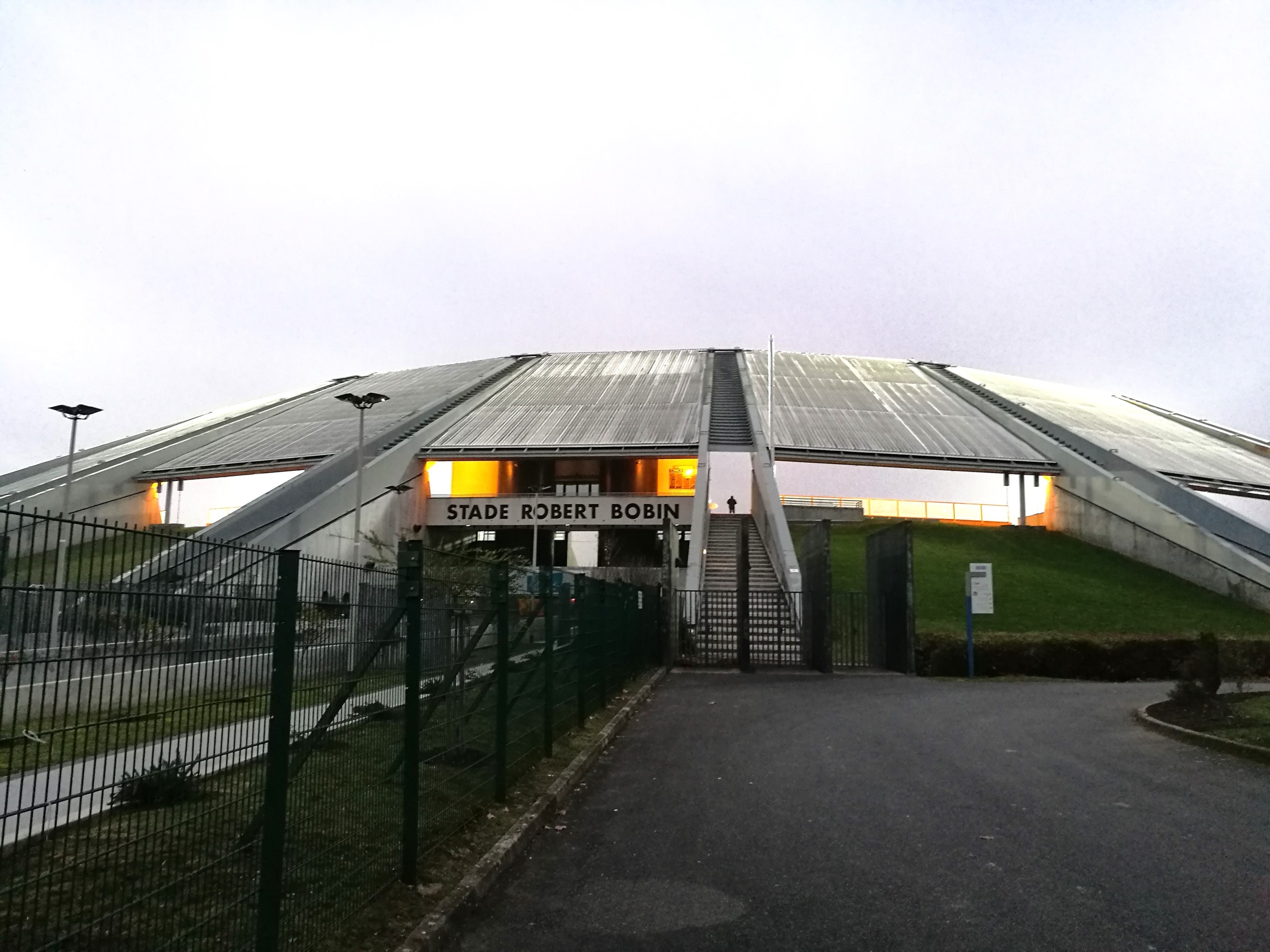
A Concrete Monstrosity
In the round of 64, played in December, so earlier than normal – first division Girondins de Bordeaux put no less than ten past the Mayotte side, while St. Dennis went down 5-2 to Jura Sud
Last season, AS Ilienne Amateurs again took the Saint Pierre and Miquelon spot. They were sent south the the Mediterranee region, where they lost 6-0 to Luynes Sports, a seventh tier side.
In the seventh round, Nouvelle Caledonie returned to the fray, with their representative being Hienghene Sport. They came to France and lost 2-1 to Olympique Sain Quentin (fourth tier). I think it is now thought that Mayotte does not have a stadium suited to this round, and hence their team again travelled to the mainland, drawing away to second division Annecy. No surprises this time, as they went down by 8-1.
AS Venus were again the Polynesian representative, this time at home, which is a fantastic trip for ASM Belfort. The fourth level mainland side enjoying their trip and returning after a 3-0 win.
Despite all four of the eighth-round entrants playing in France during the the 2021-2 season, the Guadeloupe and Martinique teams were supposed to have been at home, so they came to France again in 2022-3. French Guyana and Reunion teams would get home ties. Only La Tamponnaise of Reunion scored a goal, but that was enough to get them to France to play RC Grasse in the next round. Grasse ending the run with a 1-0 win.
So this season, I had been warned in advance that the Saint Pierre and Miquelon side were due to play in Brittany. This would be the fifth different region that a team from the territory had visited, (out of five visits). One wonders if they will, in turn be sent to all 12 or 13 of the mainland French regions, (the 13th is Corsica – which is a bit more difficult). I was really pleased to discover they would play close to Rennes, which meant a journey for me of just over two hours. Still, it was a Saturday game and this can be a difficulty for me at the moment. Still, after some discussion, I managed to get cover at home and set off.
The visitors were AS Saint Pierre, their third appearance at this stage, (compared to AS Ilienne Amateurs’ two). AS Miquelon, the team on the other island have yet to make the trip. Although it is around 4,000 kilometres from the islands to Brittany, they have a much longer journey, as they first have to head in the wrong direction, via Halifax (the one in Nova Scotia) and Montreal before overshooting their destination and ending up in Paris.
The Stade Jean Chassebouef
Here at least they are well looked after, at the national training centre in Clairefontaine, coming out the Brittany a day or two before the game. All in all, they will be away from home for about a week. The trip is entirely paid for by the French Football Federation, as of course are all the other trips between the territories and the mainland later in the tournament. The flights can be really expensive, so while they would have decent support, most of these were members of the diaspora in France. I have noticed this before, that while the sides playing in France have decent support, most of them are now based in France itself. Movement is of course easy as the population of all of these territories are citizens of France and have free movement to France (and hence to the rest of the European Union).
I had read up in advance, and it appeared that there was serious hope that this trip, to a seventh tier team could present a good chance for progress in the Coupe for the first time. If this was to happen, then what next? I ask, hoping to hear that they could play at home. In fact, next would be just four days later. If they had won this match, they would be given another game, still in Brittany in the next round and it would be brought forward to the Wednesday following this game.
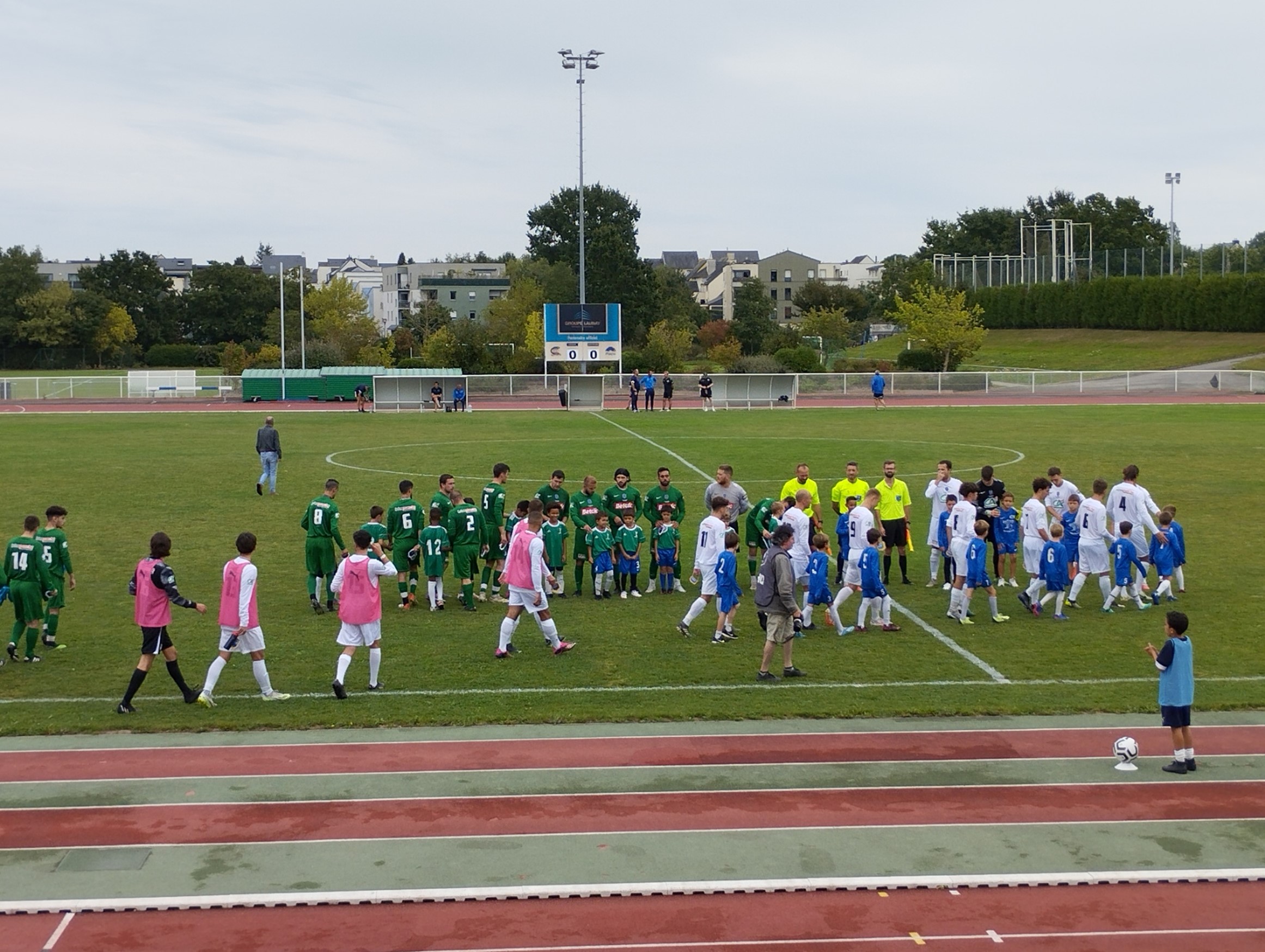
The teams come out for the game. The kits are not the clubs standards, but the sponsor supplied kits with Coupe sponsors’ names and logos. These are given out to all clubs from the fourth round onwards, but clearly this match deserves them one round earlier. Probably as it is on live TV, (in St. Pierre and Miquelon).
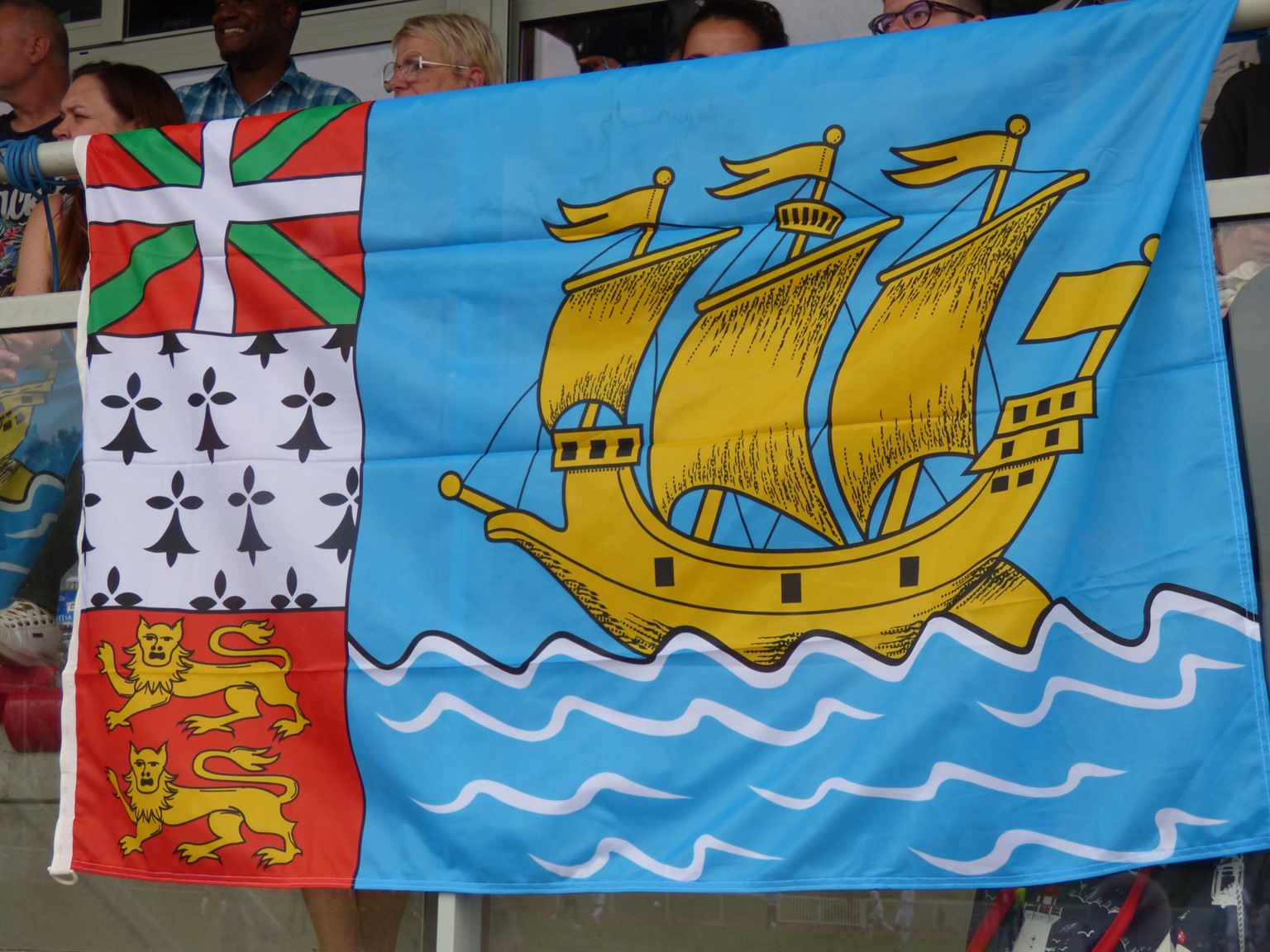
St Pierre and Miquelon Flag. The ship is not surprising for a territory from two small islands. The three parts on the left show where the colonists mainly arrived from, the Basque country, Brittany and Normandie.
The home side is Club Olympique Pace, from what appears to be a prosperous small town close to Rennes. In municipalities like this, good sports facilities are a matter of pride and proof of the ability of the local government, and this complex, (which goes well beyond a simple running track and football field) is really top class.
No charge is made for admission, and by my estimation there are around 400 people present. Some 20% of them are clearly supporting the AS St. Pierre team. I am told that they tend to head to smaller towns in France as the cities seem too crowded after living in a small community.
As for the match; it is as close as a team from this territory has come to a win in the third round. After requiring a fine save to avoid an early goal against, St. Pierre start to take the game to their opponents and are on top as half time approaches. After the break though, their intensity falls off. It appears they do not have the same fitness levels as the home side, and they are trying to hold onto the scoreless draw and a chance through a penalty shoot-out.
Sadly for St. Pierre (and happily for the home side), one good move on the left ten minutes before time, and a good cut back give the ball to Steven Barru and he powers the ball into the centre of the net.
A short highlights reel, from the official broadcast can be found at https://la1ere.francetvinfo.fr/saintpierremiquelon/coupe-de-france-de-football-l-assp-sort-la-tete-haute-en-ne-s-inclinant-qu-1-a-0-a-pace-1428926.html
If I understand correctly, and the current pattern is unchanged, teams from Mayotte and Polynesia will come to France in the middle of November for the seventh round, while a mainland team will make the long journey to Nouvelle Caledonie, (that one is the longest in any domestic football competition in the World, mainly because it is around 500 km longer than the trip from France to Polynesia). If either of the Pacific sides survive, then I think they reverse the journeys in the next round – but I am not certain Mayotte can have home ties.
In the eighth round, it should be Guadelope and Martinique staging games, while those from French Guyana and Reunion will travel.
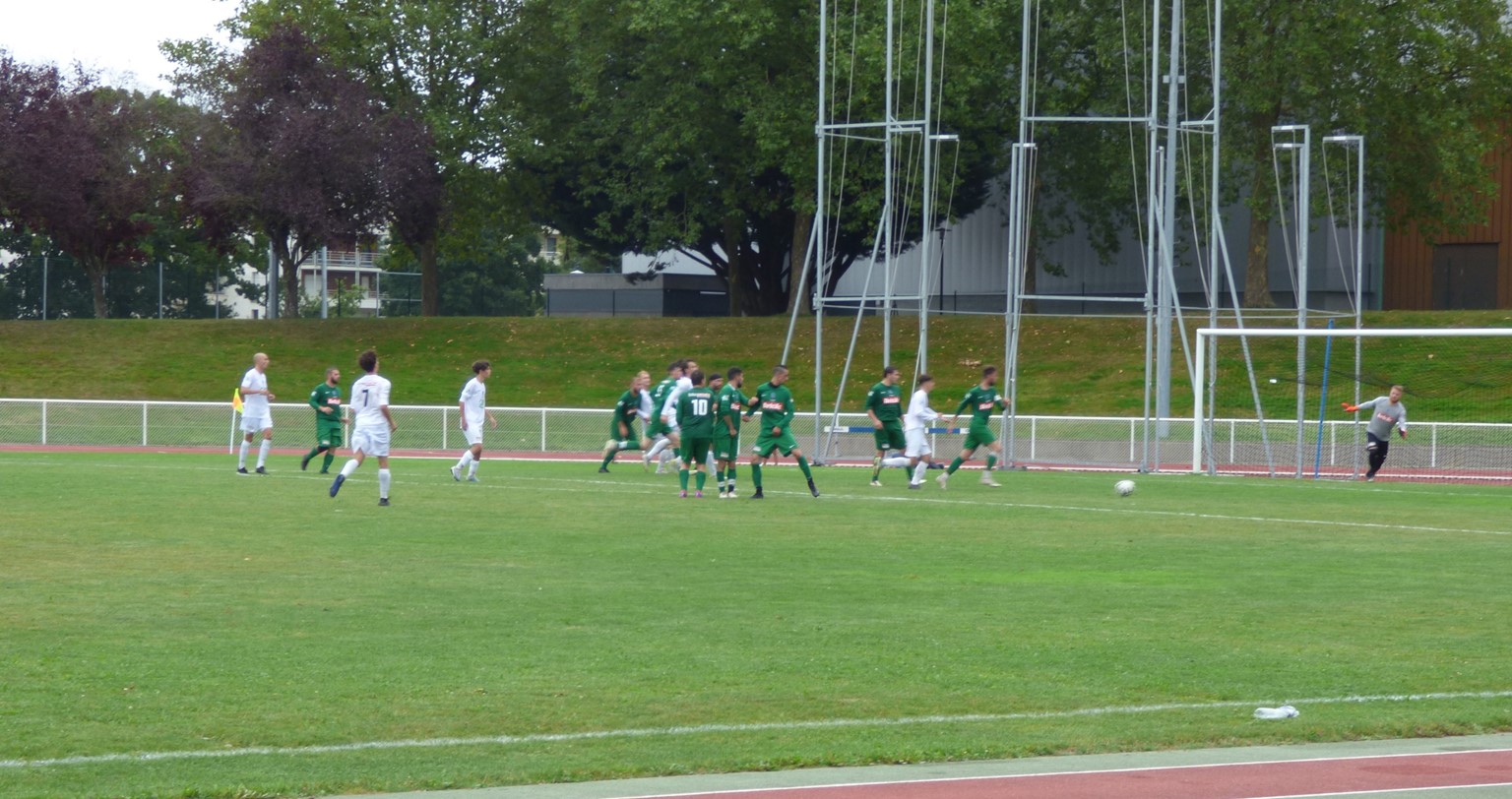
I asked in there was any thought of Saint Pierre and Miquelon starting an international side, and got a very uncertain answer, before being told it is unlikely as the French Football Federation will not support such a move. I had heard the same from the Caribbean associations, as to their chances of joining FIFA.
The official count for clubs in this season’s Coupe de France is 7,355. I am unaware of any competition that even comes close to this sort of number. It is around ten times the number of clubs in the English FA Cup, (but the same number of rounds). The count includes 341 Outre Mer teams, again an FFF number. Saint Pierre and Miquelon, along with the Caribbean and Indian Ocean teams all run qualifying competitions under the Coupe de France banner, and all of the entrants to these are in the count. French Polynesia and Nouvelle Caledonia are considered separately, with any qualification being outside the Coupe de France, so they add one each to the count.
Of the seven Outre Mer territories in the Coupe, the two furthest away from France, French Polynesia (aka Tahiti) and Nouvelle Caledonie are full members of the Oceania Football Confederation and FIFA. They do play in qualification for World Cup and other international tournaments. Their clubs also play in the Oceania Champions League and Hienghene Sport (Nouvelle Caledonia) are one of only two teams from outside New Zealand or Australia to win the title. (Australia is no longer eligible, having switched to the Asian Football Confederation).
Reunion is an associate member of the Confederation of African Football, Mayotte is not. Neither seem to take part in any competition run by the CAF at either club or national level.
The Caribbean trio, Martinique, Guadeloupe and French Guyana are members of CONCACAF and take part in all the Confederations competitions, apart from World Cup qualification, (as they are not members of FIFA). A further French territory, Saint Martin has the same status, as do Bonaire and Sant Maarten, which are territories (or officially kingdoms) of the Netherlands.
When I toured these islands in 2018, I was told they all want to join FIFA, with the French ones not expecting much progress because the French association does not support this, while the Netherlands pair felt they had support from the Netherlands itself. Still five years later nothing has changed. I don’t think those at FIFA are acting against the attempts of more small nations to join, but I think they are actively ignoring them at every step. It appears that when you applied is key as territories with less claim than these are full members of FIFA, while others with even more reason to be accepted, (such as the Oceania pair of Kiribati and Tuvalu) cannot manage to get further in their attempts.
As to the French Cup, surely both the remaining collectivities in the Caribbean have as much right to a place in the Coupe de France as St. Pierre and Miquelon. St. Martin has a similar population to St P & M, while St. Bartelemy, despite being a smaller island has a larger population. Both have functioning football competitions with more than three teams. The St. Martin one gets mentions on the FFF apps. I recall finding some mention of St. Barthelemy football when researching for my 2018 trip, but not being able to be certain and then discovering that it was an extremely expensive island to visit.
